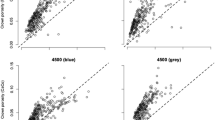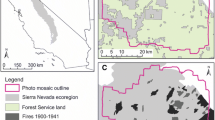Abstract
The US National Park Service must map forest cover types over extensive areas in order to fulfill its goal of maintaining or reconstructing presettlement vegetation within national parks and monuments. Furthermore, such cover type maps must be updated on a regular basis to document vegetation changes. Computer-aided classification of small scale aerial photography is a promising technique for generating forest cover type maps efficiently and inexpensively. In this study, seven cover types were classified with an overall accuracy of 62 percent from a reproduction of a 1∶120,000 color infrared transparency of a conifer-hardwood forest. The results were encouraging, given the degraded quality of the photograph and the fact that features were not centered, as well as the lack of information on lens vignetting characteristics to make corrections. Suggestions are made for resolving these problems in future research and applications. In addition, it is hypothesized that the overall accuracy is artificially low because the computer-aided classification more accurately portrayed the intermixing of cover types than the hand-drawn maps to which it was compared.
Similar content being viewed by others
Literature cited
Akca, A. 1971. Identification of land use classes and forest types by means of microdensitometry and discriminant analysis. Pages 147–165in Proceedings, application of remote sensors in forestry. International Union of Forest Reserch Organizations Section 25.
Bray, J. R. 1956. Gap-phase replacement in a maple-basswood forest. Ecol. 37(3): 598–600.
Bray, J. R., and J. T. Curtis. 1957. An ordination of the upland forest communities of southern Wisconsin. Ecological Monographs 27(4): 325–349.
Bryant, E. S., A. G. Dodge, Jr., and S. D. Warren. 1978. Satellites for practical natural resource mapping? A forstry test case. Pages 219–226in USDA Forest Service Gen. Tech. Rep. RM-55.
Coggeshall, M. E., R. M. Hoffer, and J. S. Berkebile. 1974. A comparison between digitized color infrared photography and multispectral scanner data using ADP techniques. LARS Info. Note 033174. Laboratory for Applications of Remote Sensing, Purdue Univ. 10 pp.
Cooper, W. S. 1913. The climax forest of Isle Royale, Lake Superior, and its development. Bot. Gaz. 55:1–44, 115–140, 189–235.
Fredrick, D. J., and L. Rakestraw. 1976. A forest type map of Pictured Rocks and Apostle Island National Lakeshore from the original General Land Office Survey Records. Mich. Tech. Univ. Report to the Midwest Reg. Office of the US National Park Service. 75 pp.
Freese, F. 1962. Elementary forest sampling. Pages 20–36in USDA Forest Service Agricultural Handbook No. 232.
Heinselman, M. L. 1974. Restoring fire to the canoe country. Jour. of the Sigurd Olson Institute of Environmental Studies 2(1): 14–23.
Hoffer, R. M. 1971. ADP, multiband and multiemulsion digitized photos. Pages 989–1001in Purdue Univ. Agr. Exp. Sta. Paper No. 4736.
Hoffer, R. M. 1976. Techniques and applications for computer-aided analysis of multispectral scanner data. LARS Info. Note 062276. Laboratory for Applications of Remote Sensing, Purdue Univ. 11 pp.
Hoffer, R. M., and M. D. Fleming. 1978. Mapping vegetative cover by computer-aided analysis of satellite data. Pages 227–237in USDA Forest Service Gen. Tech. Rep. RM-55.
Hoffer, R. M., M. D. Fleming, L. A. Bartolucci, S. M. Davis, and R. F. Nelson. 1979. Digital processing of Landsat MSS and topographic data to improve capabilities for computerized mapping of forest cover types. LARS Tech. Rep. 011579, Laboratory for Applications of Remote Sensing, Purdue Univ. 159 pp.
Kan, E. P., D. L. Ball, J. P. Basu, Lockheed Electronics Company, Inc., R. L. Smelser, and USDA Forest Service. 1975. Data resolution versus forestry classification and modeling. Pages 1B-24–1B-27in Proceedings, symposium on machine processing of remotely sensed data. LARS, Purdue Univ.
Kessell, S. R., and P. J. Cattelino. 1978. Evaluation of a fire behavior information integration system for southern California chaparral wildlands. Environ. Man. 2(2): 145–151.
Kowalski, W. L. 1976. Geology, soils, and recreational limitations of Bear Island, Wisconsin, Apostle Islands National Lakeshore. M.S. Thesis, Mich. Tech. Univ. 199 pp.
Leopold, A. S., S. A. Cain, C. M. Cottam, J. N. Gabrielson, and T. L. Kimball. 1963. Wildlife management in the national parks. Amer. For. 69(4):32–35.
Maissurow, D. K. 1941. The role of fire in the perpetuation of virgin forests of northern Wisconsin. Jour. For. 39(2):201–207.
Mead, R. A., and M. P. Meyer. 1977. LANDSAT digital data application for forest vegetation and land use classification in Minnesota. Pages 270–281in Proceedings, fourth annual symposium on machine processing of remote sensing data. LARS, Purdue Univ.
Payandeh, B. 1974. Spatial pattern of trees in the major forest types of northern Ontario. Can. Jour. For. Res. 4(1):8–14.
Scarpace, F. L. 1978. Densitometry on multi-emulsion imagery. Photogrammetric Eng. and Remote Sensing 44(10): 1279–1292.
Stearns, F. W. 1949. Ninety years change in a northern hardwood forest in Wisconsin. Ecol. 30(3):357.
US National Park Service. 1968. Compilation of the administrative policies for the national parks and national monuments of scientific significance (natural area categories). US Gov. Print. Office. 71 pp.
Zsilinszky, V. G. 1966. Photographic interpretation of tree species in Ontario. The Ontario Departmrent of Lands and Forests, Canada. 86 pp.
Author information
Authors and Affiliations
Rights and permissions
About this article
Cite this article
Bliss, J.C., Bonnicksen, T.M. & Mace, T.H. Computer-aided classification of forest cover types from small scale aerial photography. Environmental Management 4, 499–510 (1980). https://doi.org/10.1007/BF01876887
Issue Date:
DOI: https://doi.org/10.1007/BF01876887




